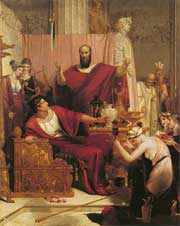|
| |
The Sword of Damocles
Main
Article page |
Beauty articles
|
Health page |
Computers|
Diseases |
Education |
Family
Fitness|
Fruits and Vegetables
|
Jobs |
General |
Personality|
Technology
|
Tourism

We always used to hear " The sword of
Damocles". What is the story behind this?
The Damocles was an courtier in the
court of Dionysius II of Syracuse, a fourth century BC tyrant of Syracuse,
Italy. Pandering to his king, Damocles exclaimed that, as a great man of power
and authority, Dionysius was truly fortunate, as it was "good to be the king."
Realizing the folly of this courtier, Dionysius offered to switch places with
him for a day, so he could taste first hand that fortune. The King required only
that Damocles sit in the king's throne for the entire day. Damocles could think
of no other place he would rather be and quickly accepted the King's proposal.
The day finally came with Damocles having invited all his friends to the table
to impress them with his one day of serving as king. He arrived fashionably late
and, having received homage from his friends, sat down in the king's throne at
the head of the table to enjoy his day. While his friends were dutifully servile
to their "one day king," they appeared uneasy. Damocles sensed the uneasiness
and looked about the room. Soon he looked up and realized there was a huge sword
hanging above the throne, and his head, held at the tip only by the single hair
of a horse's tail. Damocles immediately stood up and moved away from the throne.
Dionysius, standing nearby, quickly reminded Damocles of the contingency that he
agreed to remain on the throne for the full day. Damocles sat back down in the
throne, but only for a few moments, unable to overcome the threat of the hanging
sword. Finally, Damocles left the royal chamber in fear and shame.
From this story are two morals: First, "Uneasy rests the head that wears the
crown." Second, and perhaps more prophetically, "The value of the sword is not
that it fall, but rather, that it hangs." The first moral supports the age-old
understanding that, while it may appear to be enviable to wear a crown of power,
there are threats--at all times--to the one who wears the crown. The second
moral is more relevant particularly to the 20th century and beyond; namely, it
blends the theory of MAD (mutually assured destruction) as it relates to those
with a nuclear potential, and that of terrorism; namely, that the threat of
terrorism is greater than the act thereof.
( Reference: Wikkipedia)
| |
|



